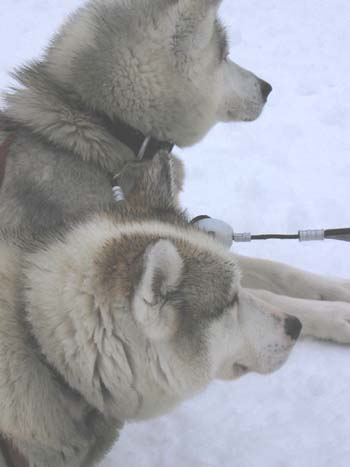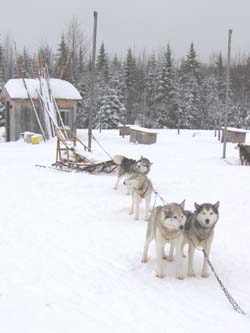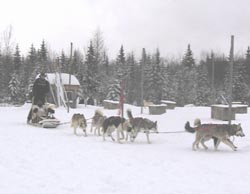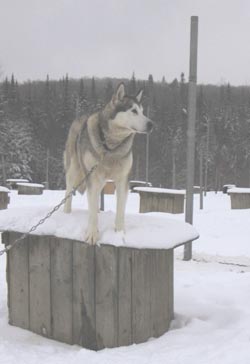Wild
Spirit of Quebec |
||||
|
|
|
|||
Memories of those stories of wild adventures in far northern frontiers came rushing back when my travel companions and I arrived at Aventure Inukshuk. This unusual ecotourism business is based at Duchesnay Tourist Station not far from Québec City. The sky, heavy and menacingly grey, threatens snow as we emerge warmly clad from our van. We are greeted by the majestic cacophony of dogs yapping their welcome. A field of individual dog houses stretches across an extensive field as we survey a pack of almost 150 canines. I have never seen so many dogs in one place. It might have been overwhelming if we were not welcomed by a friendly husky. He is a retired sled dog who has claimed his right to amble freely. This husky is huge, a beautiful bear-like creature with eyes like blue glacier ice. Although his colouring speaks of his ancient wolf ancestors, he belongs to one of the oldest breeds of domesticated dogs. His keen, friendly interest in us expresses the thousands of years of interdependence between his breed and the Inuit, the indigenous peoples of the far North. These beautiful creatures were much more than just muscle for transportation. The gregarious huskies provided companions in a hostile environment. They have a natural inclination to seek contact with other dogs and humans and are typically friendly and comfortable with strangers. In the role of hunting assistants, they could locate the breathing holes of seals in a vast landscape of ice and were courageous enough to keep polar bears or musk ox at bay. Some 400 years ago, early European immigrants found these dogs invaluable as they trapped, mined and settled in Québec and other parts of the country. After canoes, dogs were the most common form of transportation as the fur trade developed in the northern areas of the New World. Our guides at Aventure Inukshuk are men and women who, like the huskies, look perfectly at home in the freezing outdoors. They escort us past the large field of wooden doghouses and shift fluidly between French and English. They speak with passion about these creatures. Originally three breeds were used for sledding: the Malamute, Eskimo and Siberian. These are the dogs we often refer to collectively as “Huskies.” Nowadays interbreeding with Labradors for strength, and with Greyhounds for speed is common practice. Our guides tell us these dogs work hard all winter; they are superb athletes and can pull up to twice their weight. Summertime activities are kept to a minimum as their densely furred bodies can quickly become overheated. Now we head for a sledding demonstration and my group becomes just a little anxious. We are sure there must be more to dog sledding than placing our feet on the runners at the back of the sled and clinging to the driver bar. Our instructor shows us how to apply a rudimentary-looking metal brake that digs into the snow at the back of the sled. Simply stepping on this metal claw thrusts it into the snow and slows down the team. I do a quick scan for the reins and then the instructor disabuses me of the notion. |
|
|||
In fact
the experienced driver, or “musher,” controls the dogs
using verbal commands such as “gee” for a right turn and
“haw” for a left. However, such commands are not really
effective until you have established a rapport with your dog team.
And this bond of love, respect and discipline is earned over a period
of time. We will not reach this level of sophistication today but
our guide assures us the dogs will follow the trail through the forest,
and with a broad grin he guarantees the sled will follow the dogs.
He warns us never to lose contact with our sleds. If the musher lets
go, the dogs won’t be stopping. “Stop!” or “Arrête!”
are not in their vocabulary. They will simply continue to follow the
trail with enthusiasm and head for home at break-neck speed. Annie and I jokingly discuss emergency procedures. We agree that if I yell “Ahhh!” it will be her signal to hurl herself from the sled because I’ve lost contact and disaster is imminent. Our guide reassures us that none of their novice mushers have had a major mishap. And suddenly the restraining rope is released. I place my feet firmly on the 2 inch-wide runners that project from the back of the sled, and suddenly we are on our way in a long line of sleds and dogs snaking into the forest. The barking stops. The dogs run fast and with a free, graceful action. The forest closes around us. It takes my breath away; now there are just the sounds of paws on snow, the chilling air on my face. The forest landscape is magical, dropping away to a river on my right where sage-green water flows lazily over ice-covered rocks. My lungs fill with crisp, pure air. I inhale the smell of the frozen, slumbering land. I no longer feel anxious. For a brief time I am part of this team, part of this season and part of this landscape. We are participating in an experience that connects us not only to the history of this province, but also to the thousands of years of history before European settlement. It was a time when indigenous peoples lived in delicate balance with their environment. Their culture and survival was inextricably linked with these magnificent dogs who helped them coax sustenance from some of the most ferocious terrain on earth. This afternoon at Aventure Inukshuk the history of this land has come alive for me. I feel as if I have glimpsed a different way of life and the ancient wild spirit of this province. And then, all too soon, it is over and we are climbing back into the van, damp, exhausted but exhilarated. The snow is now heavy and the light is fading. I hold a new memory of adventure. It is time to return to the beautiful walled city of Old Quebec. I look forward to the evening ahead knowing my senses have been heightened in a very special way. I am hungry for the traditional Québécois cuisine that is to come. Aventure Inukshuk |
||||



